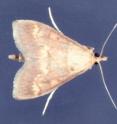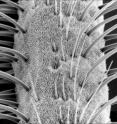Love at first sniff: Male moths go by first impressions
Related images
(click to enlarge)
An international team of researchers, including an entomologist at the University of California, Riverside, has an explanation for why we see so many hybrid moths in nature. The team closely examined the behavior and the olfactory circuitry of male moths and found an answer in female-produced pheromones -- chemicals generally consisting of a blend of two to several derivatives of fatty acids. Male moths use pheromones to find females. To avoid mating with the wrong moth species, the pheromone blends are specific for each moth species, with only males of the same species "understanding" these volatile messages -- a result shown many times during the last 40 years of research on moth pheromones. The researchers focused on the European corn borer, a moth species in which males often mate with females from a different strain.
Strains are variants, forms of the same species. While two different species cannot mate with each other, strains, being from the same species, can.
To understand the mating behavior of the European corn borer, first, the researchers followed the flights of males to female pheromones in a wind tunnel. Each strain of the European corn borer uses a blend of pheromone components in a very specific ratio. But to their surprise, the researchers found that as the male moth flies upwind along the pheromone plume, its olfactory circuitry loses the ability to measure this ratio.
"This happens because receptors in the moth brain for each pheromone component have differential rates of sensory adaptation and each type of receptor begins to fire at a different rate, causing the input into the moth's brain to change as the moth flies along the plume," explained Teun Dekker, a former UCR graduate student and now an associate professor at the Swedish University of Agricultural Sciences, and a coauthor on the study. "To overcome this mismatch, moths rely on the ratio they detected in their first encounter with the plume."
According to the researchers, this "mental short cut" is needed for male moths to continue their orientation along the plumes which, from a sensory input viewpoint, seem to be changing in pheromone component ratio.
"Once male moths lock onto a pheromone plume, they are much less attuned to blend quality," Dekker said. "In other words, males fly even to blends that were initially unattractive, and so can mate with females of different strains that they would not have approached otherwise, explaining why we find hybrid moths in nature."
Study results appeared online April 15 in the Proceedings of the National Academy of Sciences.
Experimental details
The researchers conducted a series of behavioral experiments with overlapping pheromone plumes as well as plumes that sharply transitioned from one blend to another in a wind tunnel at the Swedish University of Agricultural Sciences. They chose the European corn borer moth to study for its narrow tuning to a binary blend of female-produced 14-carbon-chainlength acetates, called here Z11 and E11 for simplicity. Two strains exist, the Z and E strains, which produce and prefer blends of differing ratios of the Z11 to E11 pheromone components.
The researchers installed pheromone lures of each strain in the wind tunnel, as well as an intermediate, hybrid lure. Next they exposed males to the partially overlapping pheromone plumes released by these lures, thus mimicking plumes occurring in nature when a large number of moths are present.
They found that males were initially attracted to lures releasing pheromones produced by females of their own strain. But after taking flight, the males "relax their specificity," that is, they are less particular about which lures they fly to. For example, in a choice between three partially overlapping pheromone sources in one experiment, 58 percent, 38 percent and 4 percent of Z-strain males landed on Z, H and E lures, respectively.
"What we generally recognize as a distinctive smell -- the scent of a flower or the aroma of coffee -- typically consists of a mixture of many different chemicals," said study coauthor Ring Cardé, a distinguished professor of entomology who holds the Alfred M. Boyce Chair in the UCR Department of Entomology. "This is the signature of a particular bouquet -- the presence of a blend of many chemicals often in specific ratios. Our work suggests that it could be the first impression -- the first whiff of odor -- that determines the ability of an insect to recognize that odor mixture."
Next, the researchers will examine if a response specific to odor blends is altered in other moth species and organisms such as mosquitoes after their first encounter with an odor mixture.
Zsolt Kárpáti at the Hungarian Academy of Sciences and Marco Tasin at the Swedish University of Agricultural Sciences also contributed to the study. Dekker worked in Cardé's lab, graduating from UCR with a doctoral degree in 2002.
Cardé, who spent three months in 2011 in Sweden to conduct the research, was supported by a grant from the Swedish Royal Academy of Natural Sciences, Medicine and Technology.
Source: University of California - Riverside
Other sources
- Love at first sniff: Male moths go by first impressionsfrom Science BlogWed, 17 Apr 2013, 13:30:18 UTC
- Love at first sniff: Male moths go by first impressionsfrom Science DailyTue, 16 Apr 2013, 17:01:16 UTC
- Entomologists focus on moth pheromones to explain high proportion of hybrid moths in naturefrom PhysorgTue, 16 Apr 2013, 13:00:57 UTC

